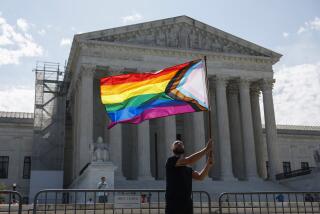Report Shows Women Wait Longer to Wed : Census: The 1990 data also shows a decline in the divorce rate and an increase in the number of children growing up in single-parent families.
- Share via
WASHINGTON — Women are waiting longer than ever to marry and, although 90% of current young adult American women are expected to marry at some time in their lives, the number is lower than the historical rate of 95%, according to a Bureau of Census report released today.
The report, based on a 1990 survey of women, reveals evidence of other new trends in marriage but stops short of identifying the causes.
Arthur Norton, a bureau analyst and co-author of the report, noted that the trend toward delaying marriage actually began in the 1970s. But it had become far more pronounced by 1990. Thirty-eight percent of women 20 to 24 years old were married for the first time that year, down from 63% in 1975, the report said.
“It’s the idea of women having a little more independence and not having to marry out of economic necessity,” said UCLA family psychologist Irene Goldenberg.
Much of the data in the report refutes expectations that had arisen during the 1980s, including evidence that the divorce rate declined--as did the likelihood that remarriage would end in divorce--as the decade drew to a close.
Twenty-nine percent of all divorced women who remarried had divorced again by the survey date, down by more than 10% from surveys in the early 1980s.
Another of the most striking shifts was the decreasing percentage of black women who marry. In 1975, about 94% of white women and 87% of black women in their early 30s had married, the report said. But in 1990, the percentage of married white women aged 30 to 34 had fallen to 86%, while the percentage for black women of the same ages had plummeted to 61%, the Census Bureau said.
In all, fewer than three of four black women will eventually marry, compared with at least nine of 10 white women.
Another trend that has continued over the last two decades is the increasing percentage of children who grow up in single-parent families.
“A larger proportion of women will remain unmarried during their principal child-bearing years and thus be subject to the risk of an out-of-wedlock pregnancy,” the report said.
“The problems of single parents today are still, for the great majority, the problems of single mothers,” and this trend will result in additional strains on government social and economic programs that sustain such families, the report said.
“It certainly fits in with President-elect Clinton’s own childhood,” said Goldenberg, adding that she hopes Clinton will push hard for legislation that would provide more short-term financial support for single parents.
“He’s gone a long way toward recognizing that there are alternative lifestyles.”
Norton surmised that the lower divorce rates seen recently may be a result of the increased realism among the younger generations in their expectations about marriage.
While baby boomers paid a higher price in terms of divorce for societal changes in the late 1960s and 1970s, “their successors have had the benefits of the pioneering efforts of their sisters and mothers before them,” he said.
But Julie DiCerbo, a psychotherapist who counsels families in Fairfax, Va., remains skeptical of such explanations.
From her own professional experience, she said that she has witnessed an increasing number of families who stay married because of the financial burden of divorce and of raising children as single parents. She also said legislation that provided legal aid to women seeking divorce was phased out at the beginning of the 1980s.
“People have less money to live on than before,” she said, “so you see more people who live in the same house in an estranged relationship.”
More to Read
Sign up for Essential California
The most important California stories and recommendations in your inbox every morning.
You may occasionally receive promotional content from the Los Angeles Times.













